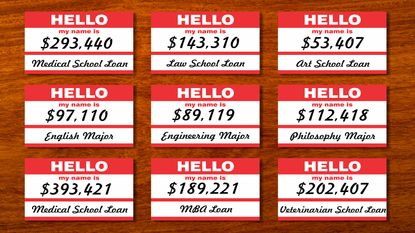Biden Extends Student Loan Relief, Is Loan Forgiveness Next?
On his first day as president, Joe Biden continued the suspension of student loan payments until October.


At the request of President Biden, the Department of Education is extending the pause on federal student loan payments and collections, and keeping the interest rate on loans at 0%, through the end of September 2021. The new president made the request hours after becoming the 46th President of the United States. This was something he pledged to do on "day one," and he followed through on that promise.
The CARES Act, which was enacted in March 2020, first suspended student loan payments until September 30, 2020, without penalty or interest for all federally owned loans. This covered over 95% of student loan borrowers. Collection activities against borrowers who were already behind on payments was also suspended.
At the time, most people thought the coronavirus crisis would be behind us by September 30. However, as the pandemic dragged on and got worse, the CARES Act student loan relief provisions were extended multiple times. The latest extension paused student loan payments until January 31, 2021. But with that date approaching, people with student loan debt were getting worried that payment requirements and interest would start up again while the pandemic is still raging. President Biden's action puts those fears to rest – at least until the end of September.

Sign up for Kiplinger’s Free E-Newsletters
Profit and prosper with the best of expert advice on investing, taxes, retirement, personal finance and more - straight to your e-mail.
Profit and prosper with the best of expert advice - straight to your e-mail.
[Stay on top of all the new stimulus bill developments – Sign up for the Kiplinger Today E-Newsletter. It's FREE!]
Student Loan Forgiveness?
The next big question for the Biden administration is whether to push for – or how hard to push for – student loan forgiveness. Although it wasn't included in President Biden's $1.9 trillion "American Rescue Plan" economic package, the new president supports a plan to forgive $10,000 or more of federally-backed student loan debt for each American (private student loan debt probably won't be eligible for forgiveness). Some progressives want more student loan debt forgiveness – up to $50,000 per person. However, we don't expect Biden to endorse anything near that level. He promised to release a second economic plan in February, and student loan forgiveness could be in that package.
President Biden has also said that forgiven student loan debt should not be subject to tax. Normally, the amount of any debt that is canceled, forgiven or discharged for less than the full amount you owe is taxable and must be reported on your tax return. There are a number of exceptions to this general rule, but in most cases forgiven student loans currently result in a higher tax bill. Expect any Biden plan to include an additional exception for any student loan debt he is able to cancel.
Other Possible Student Loan Relief Measures
As a candidate running for president, Biden also put out a plan that would lower or eliminate student loan debt by:
- Limiting student loan payments to 5% of a person's discretionary income (income minus taxes and essential spending like housing and food) over $25,000;
- Forgiving student loan debt for people who made payments for 20 years;
- Granting $10,000 of undergraduate or graduate student loan relief for every year of national or community service, up to five years; and
- Allowing the discharge of private student loans in bankruptcy.
President Biden's pre-election plan would also provide two years of community college or other high-quality training program without debt. The federal government would pay for 75% of the cost and states would cover the rest (the federal government would cover up to 95% of the cost for Indian Tribes operating community colleges serving low-income students). Biden also called for making public colleges and universities tuition-free for all families with incomes below $125,000.
In addition to student loan forgiveness, some of these ideas could make it into the second economic growth plan that the president will release in February.
Student Loans Paid by Employers
And there's some additional student loan relief that's already in the books. The CARES Act created a temporary income tax exclusion for up to $5,250 of student loan debt paid by your employer in 2020. However, the Taxpayer Certainty and Disaster Tax Relief Act, which was enacted in December, extended that tax break through 2025. The $5,250 cap applies to both student loan repayment benefits and other educational assistance (e.g., tuition, fees, books, etc.) offered by your employer.
Rocky Mengle was a Senior Tax Editor for Kiplinger from October 2018 to January 2023 with more than 20 years of experience covering federal and state tax developments. Before coming to Kiplinger, Rocky worked for Wolters Kluwer Tax & Accounting, and Kleinrock Publishing, where he provided breaking news and guidance for CPAs, tax attorneys, and other tax professionals. He has also been quoted as an expert by USA Today, Forbes, U.S. News & World Report, Reuters, Accounting Today, and other media outlets. Rocky holds a law degree from the University of Connecticut and a B.A. in History from Salisbury University.
-
 Stock Market Today: S&P 500, Nasdaq Extend Losing Streaks
Stock Market Today: S&P 500, Nasdaq Extend Losing StreaksThe two indexes have closed lower for five straight sessions.
By Karee Venema Published
-
 Save Over $40 on Audible With Amazon's Latest Deal
Save Over $40 on Audible With Amazon's Latest DealAmazon’s latest promotion lets you score three months of Audible for just $0.99 a month.
By Erin Bendig Published
-
 A Bunch of IRS Tax Deductions and Credits You Need to Know
A Bunch of IRS Tax Deductions and Credits You Need to KnowTax Breaks Lowering your taxable income is the key to paying less to the IRS. Several federal tax credits and deductions can help.
By Kelley R. Taylor Last updated
-
 Don’t Miss This $2,500 Tax Break for Paying Your Student Loan
Don’t Miss This $2,500 Tax Break for Paying Your Student LoanTax Deductions Do you qualify for the student loan interest deduction this year?
By Katelyn Washington Last updated
-
 Six Tax Breaks That Get Better With Age
Six Tax Breaks That Get Better With AgeTax Breaks Depending on your age, several tax credits, deductions, and amounts change — sometimes for the better.
By Kelley R. Taylor Last updated
-
 Biden Proposes New Homebuyer Tax Credits
Biden Proposes New Homebuyer Tax CreditsTax Credits President Biden is calling for new middle-class tax breaks including a mortgage tax credit.
By Kelley R. Taylor Last updated
-
 Will Florida Property Tax Be Eliminated?
Will Florida Property Tax Be Eliminated?Property Taxes A new proposal is raising questions about revenue generation in the Sunshine State.
By Kelley R. Taylor Published
-
 States That Won't Tax Your EV
States That Won't Tax Your EVState Tax Most states impose additional fees on electric vehicles, but these states don’t penalize EV owners, and some also offer other tax incentives.
By Kelley R. Taylor Last updated
-
 Tax Season is Here: Big IRS Tax Changes to Know Before You File
Tax Season is Here: Big IRS Tax Changes to Know Before You FileTax Filing Tax deductions, tax credit amounts, and some tax laws have changed for the 2024 tax filing season.
By Kelley R. Taylor Last updated
-
 Your Arizona Family Rebate is Taxable: What to Know
Your Arizona Family Rebate is Taxable: What to KnowState Tax Thousands of Arizona families will need to report income from special child tax relief payments.
By Kelley R. Taylor Last updated